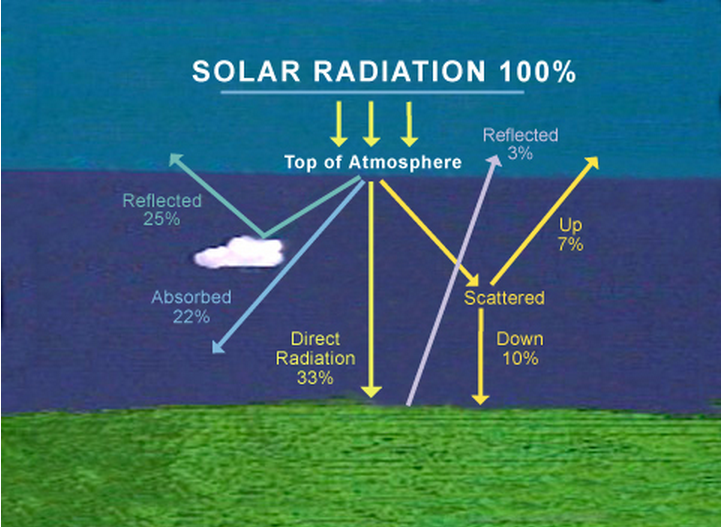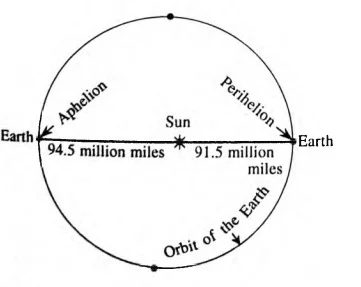Introduction: Solar Radiation’s Journey to Earth #
Solar radiation, the cosmic gift that sustains life on our blue planet, is a captivating dance of energy from the heart of our sun to the Earth’s surface. It powers our world, fuels photosynthesis, and drives the Earth’s climate. Yet, its journey is not only vital but also enigmatic, encompassing a spectrum of wavelengths, from the gentle warmth of visible light to the invisible, high-energy embrace of ultraviolet rays.
Solar Radiation : Nature’s Energy Source #
- Definition: The radiant energy received from the sun , transmitted in the form of analogous to shortwaves and travelling at 1,86,000 miles per second is called solar radiation.
- Electromagnetic Spectrum: Solar radiation comprises a wide range of electromagnetic waves, including visible light, ultraviolet, and infrared rays.
- Types of Solar Radiation: It consists of direct and diffuse radiation, with direct rays coming from the sun and diffuse radiation resulting from scattering in the atmosphere.
- Energy Transport from the Sun: Solar radiation carries the sun’s energy through space in the form of photons.
Mechanism of Solar Radiation #
- Solar Radiation Generation: Solar radiation originates from the core of the Sun, where nuclear fusion reactions convert hydrogen into helium, releasing vast amounts of energy.
- This energy is in the form of electromagnetic waves, primarily in the visible and ultraviolet parts of the electromagnetic spectrum.
- Energy Transport through Space: Solar energy, in the form of photons, travels through the vacuum of space at the speed of light.
-
- These photons are characterised by various wavelengths and energy levels .
Solar Radiation at Earth’s Atmosphere #
- Absorption, Reflection, and Transmission: The Earth’s atmosphere absorbs, reflects, and transmits solar radiation, influencing the amount reaching the planet’s surface.
- This plays a crucial role in the development of the zonal pattern of temperature on earth .
- Atmospheric Effects on Solar Radiation: Atmospheric conditions, such as clouds, aerosols, and gases, can alter the path and intensity of solar radiation.
- Clouds reflect the incoming solar radiation , while aerosols present in the atmosphere deflect the shortwave radiation .
- This phenomenon also results in the formation of a rainbow
Solar Radiation Interaction with Earth #
- Albedo Effect:
- Surfaces on Earth can reflect solar radiation (albedo effect), impacting local temperatures and climate.
- Greenhouse Effect:
- Some solar radiation is absorbed by the Earth and re-emitted as infrared radiation, contributing to the greenhouse effect.
 #
#
The Solar Radiation Cycle #
- Radiative Balance: The Earth maintains a radiative balance, where incoming solar radiation is balanced by outgoing thermal radiation, crucial for a stable climate.
- Solar Radiation and Climate: Solar radiation plays a significant role in climate patterns, including seasons and long-term climate change.
- Importance for Life on Earth: Solar radiation is the primary energy source for photosynthesis, sustaining life on our planet, and driving various Earth processes.
Distribution of Solar Radiation #
The pattern of insolation distribution on Earth can be summarised as follows:
- Latitudinal Variation:
-
- Insolation decreases from equator towards pole .
- The equator receives the most direct and intense sunlight, while higher latitudes receive less direct and less intense sunlight.
- This occurs because lower latitudes have less atmospheric absorption , longer daylight and less distance is travelled by the sunlight to reach the equator .
- Seasonal Variation: Insolation varies with the changing angle of the Earth’s axis.
- This results in seasons, with higher insolation during summer when a hemisphere is tilted toward the Sun and lower insolation during winter when it’s tilted away.
- Daily Variation: Insolation varies throughout the day due to the rotation of the Earth.
- It’s highest around solar noon and lowest during the early morning and late afternoon.
- Topographical Effects: Elevation and local geography influence insolation patterns.
-
- High mountainous regions may receive more intense sunlight, while valleys and areas with obstructions might experience variations in insolation.
- Atmospheric Interference: Cloud cover, atmospheric conditions, and pollution can scatter, absorb, or reflect solar radiation, leading to regional variations in insolation.
- Equinoxes: During equinoxes (around March 21 and September 23), insolation is relatively uniform at all latitudes, with nearly equal day and night duration.
- Polar Regions: Polar regions experience extreme variations in insolation.
- They have extended periods of continuous sunlight during their respective summers and extended periods of darkness during their winters.
 #
#
Factors Influencing Pattern of Insolation #
The pattern of insolation (incoming solar radiation) on Earth’s surface is influenced by various factors. These factors can vary by location, time of year, and time of day.
1. Angle of the Sun’s Rays
- Angle and Latitude: The angle at which the Sun’s rays strike Earth’s surface varies with latitude.
- Near the equator, the rays are nearly vertical, providing more intense insolation.
- However, as you move toward the poles, the angle becomes more oblique, resulting in lower insolation.
- Effect on Energy: Vertical rays concentrate solar energy over a smaller area, making it more intense, while oblique rays cover a larger surface area, leading to lower insolation.
- Oblique rays also travel through a thicker portion of the atmosphere, causing energy loss due to scattering and absorption.
2. Length of Day
- Seasonal Variation:The length of day varies with the seasons due to the Earth’s axial tilt.
- Longer daylight hours mean more time for insolation, while shorter daylight hours result in less solar energy received at the surface.
- Equator vs. Pole: At the equator, the length of day remains relatively consistent throughout the year, with 12 hours of daylight.
- In contrast, higher latitudes experience more significant variations in daylight duration.
3. Distance Between Earth and the Sun
- Orbital Variations: The Earth’s elliptical orbit causes variations in its distance from the Sun throughout the year.
- The difference in distance is relatively small but can affect insolation.
- When closer to the Sun (perihelion), Earth receives more insolation, and when farther (aphelion), it receives less.
- Dominant Role: While orbital variations do play a role in insolation distribution, factors like the angle of the Sun’s rays and the length of the day have a more significant impact on the Earth’s climate.
4. Sunspots
- Solar Activity: Sunspots, dark areas on the Sun’s surface, go through an 11-year cycle of increasing and decreasing numbers.
- When more sunspots are present, the Sun emits more energy, resulting in higher insolation on Earth.
- Conversely, fewer sunspots lead to reduced solar radiation.
- Complex Relationship: While sunspots influence solar radiation, the exact relationship between sunspots and insolation is not precisely understood due to the complex nature of sunspot activity.
5. Effects of the Atmosphere
- Reflection: Different surfaces, such as clouds, snow, and water, have varying reflectivity (albedo) and can either absorb or reflect incoming solar radiation.
- Diffusion:Dust particles and water vapour in the atmosphere scatter solar energy, enabling the diffusion of light, even in the presence of clouds or fog.
- Absorption:Certain atmospheric constituents, like water vapour and gases, selectively absorb specific wavelengths of solar radiation and convert them into heat energy.
- Scattering:Scattering occurs when dust particles and gas molecules in the atmosphere disperse incoming solar radiation in different directions, influencing the amount of insolation reaching the Earth’s surface
Solar radiation stands as a cornerstone of life on Earth, shaping our climate, seasons, and energy resources. Its distribution is influenced by a myriad of factors, from Earth’s latitude to atmospheric dynamics. Understanding these mechanisms is critical for harnessing solar power, comprehending climate change, and appreciating the intricate dance between our planet and the Sun.
Conclusion
Solar radiation is like a dance of energy from the sun to Earth, powering our world and shaping our climate. This cosmic gift, with its invisible rays and visible light, sustains life and influences our planet’s patterns. Understanding this dance helps us harness solar power, cope with climate changes, and appreciate the intricate connection between Earth and the Sun.
Previous Year Question
Which of the statements given above is/are correct? (a) a only (b) B only (c) Both a and b (d) Neither a nor b
Answer -D
(d) Sub-Theme: Clouds Statement 1 is incorrect: Low, thick clouds primarily reflect solar radiation and cool the surface of the Earth. Statement 2 is incorrect: High, thin clouds primarily transmit incoming solar radiation. At the same time, they trap some of the outgoing infrared radiation emitted by the Earth and radiate it back downward, thereby warming the surface of the Earth.
2. With reference to the Earth’s atmosphere, which one Are the following statements correct? (2023) (a) The total amount of insolation received at the equator is roughly about 10 times of that received at the poles. (b) Infrared rays constitute roughly two-thirds of insolation. (c) Infrared waves are largely absorbed by water vapour that is concentrated in the lower atmosphere (d) Infrared waves are a part of visible spectrum of electromagnetic waves of solar radiation Answer -c |

 GS Foundation
GS Foundation Crash Course
Crash Course Combo
Combo Optional Courses
Optional Courses Degree Program
Degree Program












